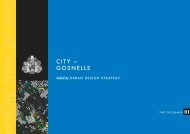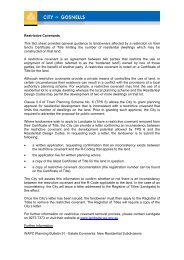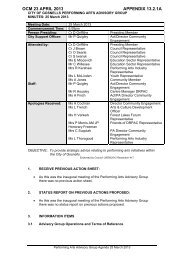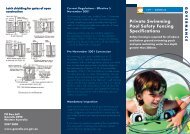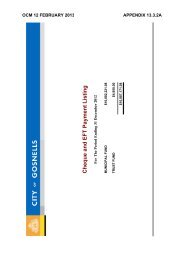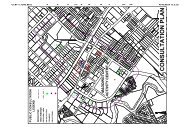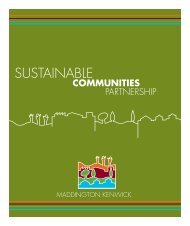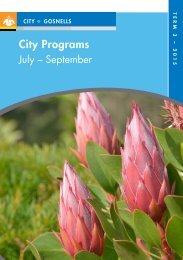Summary - City of Gosnells
Summary - City of Gosnells
Summary - City of Gosnells
You also want an ePaper? Increase the reach of your titles
YUMPU automatically turns print PDFs into web optimized ePapers that Google loves.
Flora 454. Taxonomic variantsTaxa in the MKSEA that are significant because they differ morphologically from currently accepteddescriptions and forms, and which require taxonomic study and possibly recognition as distinct taxa,include Calectasia grandiflora subsp. grandiflora R.L. Barrett ms, Comesperma cf. polygaloides (C.Tauss 2541), Hypocalymma angustifolium Mud Habitat Variant (C. Tauss 1850), Lepidosperma sp.Kenwick (C. Tauss 2598), Podolepis gracilis Swamp Form (G.J. Keighery 13255), Tricoryne aff.elatior (C. Tauss 1905), Velleia aff. trinervis (G.J. Keighery 10429) and Wurmbea dioica subsp. Brixton(G.J. Keighery 12803).4.2.3.1 Descriptions <strong>of</strong> the some taxa <strong>of</strong> regional conservation significance recorded in the currentfield survey <strong>of</strong> the MKSEASome <strong>of</strong> the regionally significant taxa that occur in the MKSEA are described below. For further taxonomicnotes, particularly for cross-referencing other names <strong>of</strong> taxa listed below, see Appendix B, Table B1. Forother information about them, see Appendix A, Table A2.Family Anthericaceae1. Tricoryne aff. elatior (C. Tauss 1905). This perennial herb was found in the MKSEA in severalpalusplain sites where Muchea Limestone was present. It had a tall, lax, tangled habit to about 1 m inheight and very scabrous stems. The form <strong>of</strong> Tricoryne elatior that is more prevalent on the SCP alsooccurred in the MKSEA, but it was recorded only in sandy, upland sites.2. Thysanotus arenarius. This fringe lily species is a calcicole that is common in sandy, upland habitatsoverlying Tamala Limestone <strong>of</strong> the Spearwood Dunes. In the MKSEA it was very abundant in someMuchea Limestone sites. It has also been noted in other sites on the eastern SCP associated withMuchea Limestone (Keighery and Keighery, 1995).3. Thysanotus dichotomus. This striking perennial fringe lily has large mauve flowers and forms thick,intricate clumps up to a height <strong>of</strong> about 1.2 m. It was on the floodplain <strong>of</strong> Yule Brook. The main range<strong>of</strong> this species is in the Jarrah Forest, Avon and Warren Bioregions. There are no previous Swan CoastalPlain collections <strong>of</strong> this species in the Western Australian Herbarium (2009). The species has beennoted several times on the SCP; near BFS 65 at Oakford adjacent to Beenyup Brook (Tauss, 2007b), atLot 61 Welshpool Rd adjacent to Yule Brook (Tauss, 2007a) and at the Greater Brixton Street Wetlands(Keighery and Keighery, 1991). Thysanotus dichotomus, as currently circumscribed, appears to includeseveral taxa (T. MacPharlane, pers. comm.), and the very robust form found at Yule Brook is in need <strong>of</strong>further taxonomic study.Family Asteraceae1. Podolepis capillaris. BFS 387 and the MKSEA are the only areas on the SCP where this daisy has beenrecorded. It is otherwise widespread in the semi-arid regions <strong>of</strong> the Southwest and Eremaean BotanicalProvinces <strong>of</strong> Western Australia. Further taxonomic studies on this form are required to establish thedifferences between it and the common, dry inland habitat form <strong>of</strong> Podolepis capillaris.2. Podolepis gracilis Swamp Form (G.J. Keighery 13255). This is a robust, glabrous form <strong>of</strong> Podolepisgracilis, with large pink or white flowers, that is known from the seasonally inundated heavy soils <strong>of</strong> thePinjarra Plain from Gingin to Busselton. Further taxonomic studies on this form are required to establishwhether it can be distinguished taxonomically from the common, upland form <strong>of</strong> Podolepis gracilis.Family Colchicaceae1. Burchardia bairdiae. This is generally a species <strong>of</strong> the Pinjarra Plain wetlands. However, populationshave recently been recorded at Piney Lake Reserve (BFS 339), at Alfred Cove Nature Reserve and atthe Serpentine River (its most southern location). In the current survey this robust geophytic herb wasfound to be very abundant in one <strong>of</strong> the Muchea Limestone areas.2. Wurmbea dioica subsp. Brixton (G.J. Keighery 12803). This is a tall hermaphrodite form <strong>of</strong> Wurmbeadioica subsp. alba that grows in sumplands (claypans) on the Swan Coastal Plain and in the Jarrah Forest(from Cervantes to Beaufort River and Lake Muir). This taxon is common in BFS 387. In the MKSEA itTauss, C. and Weston, A.S. (2010). The flora, vegetation and wetlands <strong>of</strong> the Maddington-Kenwick Strategic Employment Area.A survey <strong>of</strong> the rural lands in the vicinity <strong>of</strong> the Greater Brixton Street Wetlands. Report to the <strong>City</strong> <strong>of</strong> <strong>Gosnells</strong>, W.A. Version 18.04.10






